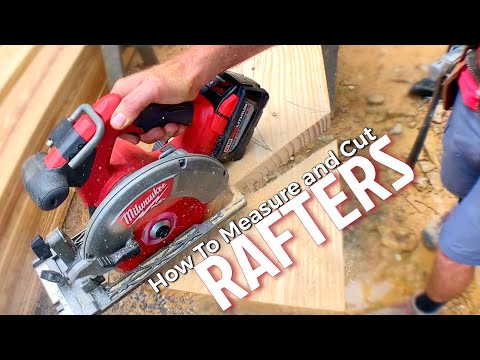
Ever wondered why every carpenter has a speed square in their toolbox? A speed square is a versatile tool that can be used for several woodworking projects.
Most people think that by using this tool, a person can draw a straight line across the board or probably square up small edges. But these are only a few uses of speed squares.
This guide discusses the uses of speed squares. Also, you will get to learn how to cut roof rafters with a speed square.
So, let’s begin.
How to Understand Speed Square Features or Markings?
Before we move to the process of cutting roof rafters with a speed square, let’s understand the features or markings of a speed square. This section will assist you in making the cutting task precise.
T-shaped End
A T-shaped end helps a speed square to stand up by itself over the side of a board or surface.
Number 1- 6 on the Side
These are numbers and marks in inches. Be noted that you can measure up to 7” by speed square, not up to 6”. The very end of the tool is measured as 7”, and it is unmarked.
Diamond-shaped Hole
From the end, this hole is 3 ½”. When doing the quick measurement, this hole is helpful as the width of 2 X 4 is ideally 3 ½”, not 4”.
Number 5 – 80 on the Long Side
These numbers are used to find the angle in degree. Don’t think that these markings are for inches. Number ae unmarked in degrees between 0 – 5 and more than 80°
Step-by-Step Process of How to Cut Roof Rafters with a Speed Square
You will find many numbers, cryptic lines, holes, and hash marks in a speed square, making it an ideal tool for home remodeling projects.
Step 01: Straight Line Drawing
As mentioned earlier, a speed square is efficient enough to draw a straight line. Even drawing a 45° angle across a wood is pretty convenient with a speed square.
This is due to the lip at one side of the speed square, which helps the tool line up accurately along the wood’s edge, providing an appropriately straight 45° or 90° angle.
Step 02: Angle Drawing
Every speed square has a pivot point that will let you draw lines at any angle with the effortlessness of old protractors in geometry class.
Pivot the angle according to your need and precisely hold the speed square to draw the line. This is especially easy for raft tail ends and other areas where you are required to draw customized angles conveniently and smoothly.
Step 03: Board Marking for Ripping
Since several notches are available in speed squares at particular intervals, you can lock the pencil wherever you need and make a straight line along the board edge.
Step 04: Fence Sawing
Making a straight cut using a jigsaw or circular saw is not an easy task because the saw can rotate slightly. So, how to solve the problem? Place the saw over the straight line and use the speed square against the saw’s base plate. The speed square will act as a fence in this regard.
This will help you to make a perfectly straight cut without much of a hassle.
Step 05: Layout Framing
With speed squares marking, you can layout studs effortlessly. You can measure 1 ½” X 3 ½” with common 2 X 4 studs. Moreover, speed squares have markings that will let you determine the next stud. Next, drawing a straight line and moving at this point is entirely unnecessary.
Step 06: Rafter Layout
If you don’t frame the roof, you might not be interested in using this feature, but that doesn’t mean this feature is ineffective. Speed squares have to be marked for normal rafter angle.
You can also figure out hips and valley angles on a roof using a speed square since it has markings for determining these 2 angles.
Step 07: Roof Slope
Wanna know the roof slope of your house? A speed square can help you determine what type of roof covering is essential for you to use.
Last Words
The uniqueness of speed squares is; that they can do a couple of things that other tools can’t do. Moreover, other exceptional benefits of speed squares are easy-to-read and fast results compared to other tools, which are bulkier and more challenging to work.
Shortly, speed square is the only square that fits in a toolbox without any trouble. In terms of accessibility, Speed Square is KING!
Hopefully, now you have no more questions regarding how to cut roof rafters with a speed square. If you have any further questions, feel free to leave a comment in the below comment box.
FAQ
Is a rafter square the same as a speed square?
Answer: Speed square is generally a trademarked name. A similar tool is called Quick Square by the manufacturer Stanley. On the other hand, Rafter Square is the name given by the manufacturer Irwin.
The different names of speed squares are triangle squares, rafter triangle squares, framing squares, etc. Multiple manufacturers, like DeWalt, Empire, Stanley, etc., manufacture speed squares under alternative names.
What is the diamond on a speed square for?
Answer: You will notice a diamond cutout along with a ruler in the Swanson Speed squares. You will be able to square precise lines with this feature. Moreover, when making a birdsmouth or notch for rafter work, a diamond cutout is beneficial.
What are the other uses of speed squares?
The other uses of speed squares are listed below-
1. Cutting trim at an angle
2. Finding a level
3. Cutting 2 X 4 square
4. Marking boards for ripping woods
5. Squaring out cabinets
6. Readjusting a saw
7. Determining roof pitch
8. Scribing straight lines
